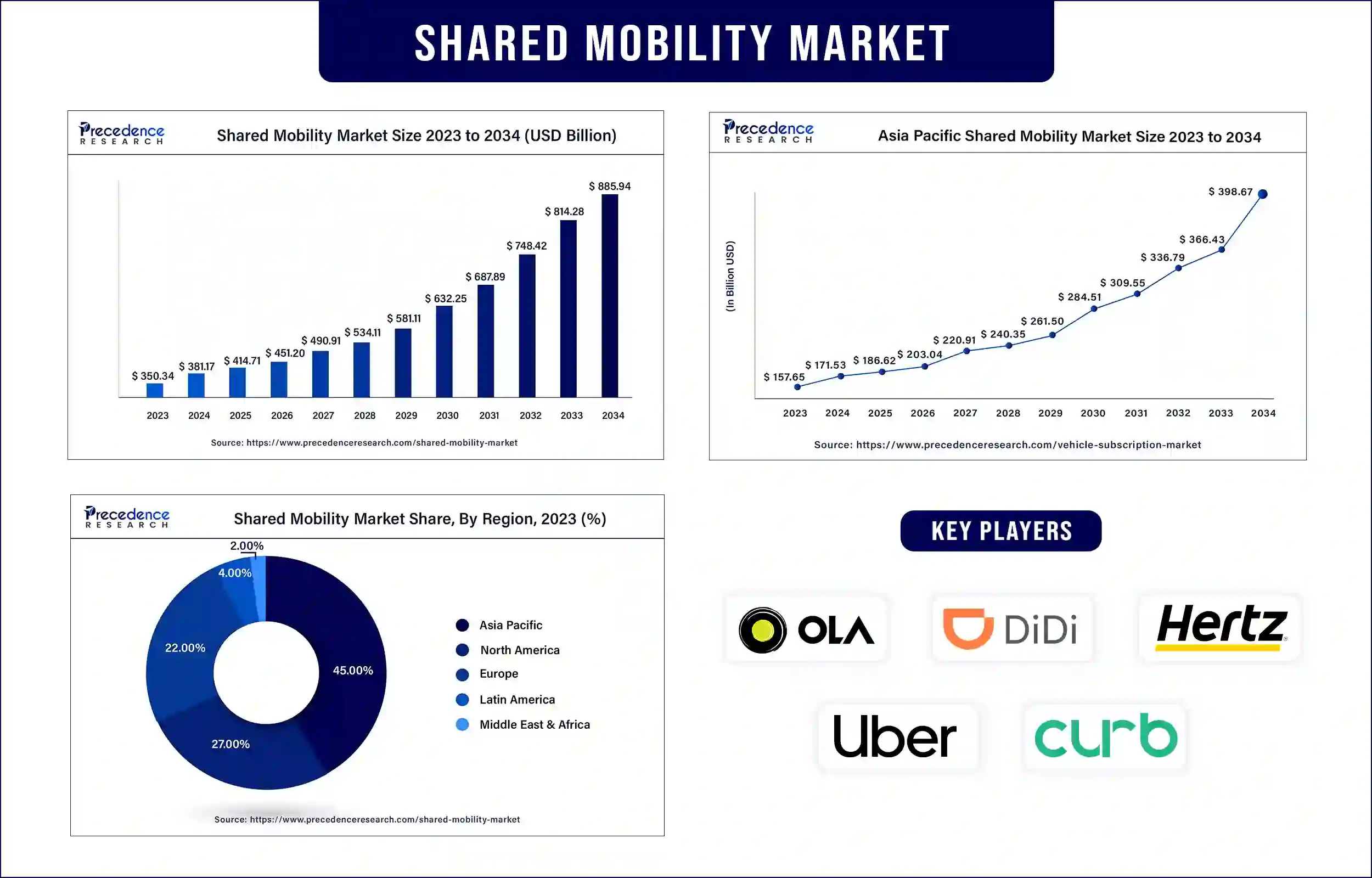Shared Mobility Market Revenue to Attain USD 814.28 Bn by 2033
Shared Mobility Market Revenue and Trends
The global shared mobility market revenue reached USD 381.17 billion in 2024 and is predicted to attain around USD 814.28 billion by 2033 with a CAGR of 8.8% during the forecast period. The market's growth has been spurred by the rising use of the Internet and investments in shared mobility.

Market Growth
The term "shared mobility" refers to travel options that separate the use of mobility resources from their ownership to increase their practical utilization. Hence, shared mobility is the temporary usage of shared automobiles as needed and convenient for the user. The government's attempts to promote shared mobility solutions to minimize traffic congestion on highways and the fast-growing integrated ecosystem within the transportation industry drive the market. Since the use of automobiles has significantly increased pollution over the past ten years, governments worldwide are promoting the use of shared mobility services, which is driving the market's expansion. Shared mobility is less expensive than purchasing and maintaining a car compared to personal automobiles.
Report Highlights of Shared Mobility Market
- By type, the vehicle rental/leasing segment dominated the market with the largest share in 2023. This is mainly due to a significant growth in the adoption of rental vehicles. On the other hand, the ride-sharing segment is expected to register considerable growth over the projection period due to consumer preferences for more affordable and opulent means of transportation over personal driving.
- On the basis of vehicle, the passenger cars segment dominated the shared mobility market in 2023 and is expected to continue its dominance throughout the forecast period. This is due to the enjoyable driving experience and lucrative amenities included in the passenger automobiles.
- By business model, the P2P segment accounted for the largest market share in 2023 due to the increasing use of automobiles for leasing services.
Shared Mobility Market Trends
Reduced traffic, improved economic activity, and availability of eco-friendly transportation: Cities and commuters may both profit from shared transportation in numerous ways. During the COVID-19 epidemic, shared mobility's practicality and effectiveness stood up as a noteworthy advantage. Ride-sharing services have developed into a reliable and cost-effective substitute for public transit. During the epidemic, ride-sharing services for bicycles, electric bikes, and scooters were very helpful. Outside the pandemic, additional long-term benefits of shared mobility include lessened traffic congestion, improved economic activity, accessibility to more urban locations, availability of eco-friendly transportation, fewer carbon emissions, and inexpensive personal transportation.
Easy availability of services through mobile apps: The use of mobile applications to reserve transportation services like automobiles, motorcycles, scooters, or buses is made possible through carpooling and e-hailing services. Private cars are utilized to provide public transportation services for passengers and fleet operators when they are reserved through these platforms.
Rise in the investment: Shared mobility is on the rise as customers demand easy, affordable, and environmentally friendly transportation options in cities. Shared mobility has grown to be a lucrative industry over the last ten years. More than $100 billion has been invested in shared mobility enterprises since past ten years by private investors, technological firms, and other parties. To combat the climate catastrophe, cities are working to reduce their emissions, and this decade may witness an even more drastic transition toward flexible, shared, and sustainable modes of transportation. Now, efforts are being made in more than 150 communities to implement policies that would limit the use of private vehicles.
Regional Insights
Asia Pacific dominated the shared mobility market in 2023. China and India seem to be the most promising markets due to their large population. Further, countries like India and Taiwan are focusing on expanding their transportation infrastructure. Moreover, there are many additional problems with owning vehicles in India, and finding parking, especially in metropolitan cities, is challenging. This, in turn, boosts the demand for shared mobility. On the other hand, North America is anticipated to be the fastest-growing region in the market during the forecast period. The region boasts a large number of market players, which are bolstering shared mobility in North America. The increasing demand for affordable transportation option propels the market in the region.
Market News
- In May 2024, Uber launched Bubbles, a champagne tour bookable directly in the Uber app. This exclusive addition to the ‘Go Anywhere’ travel series offers riders seamless access to one of Europe’s most iconic regions throughout the summer, thereby enhancing the premium travel experience.
- In March 2024, Zoomcar and EaseMyTrip unveiled a strategic collaboration aimed at providing customers with unparalleled convenience in travel planning. This integration seamlessly incorporates Zoomcar’s extensive fleet of self-drive vehicles into the EaseMyTrip platform, thus expanding the range of travel options available to users.
- In 2024, Ola, a ride-hailing platform, launched its e-bike service in Delhi and Hyderabad, with the aim to deploy more than 10,000 electric vehicles over the next 2 months across these cities.
Market Segmentation
By Type
- Ride-sharing
- Vehicle Rental/Leasing
- Ride Sourcing
- Private
By Vehicle Type
- Passenger Cars
- LCVs
- Busses & Coaches
- Micro Mobility
By Business Model
- P2P
- B2B
- B2C
By Vehicle Propulsion
- IC Engine Vehicles
- Gasoline / Petrol
- Diesel
- Electric Vehicles
- Battery Electric Vehicles (BEV)
- Plug-in Hybrid Electric Vehicles (PHEV)
By Sales Channel
- Offline
- Online
By Sector Type
- Unorganized
- Organized
By Geography
- North America
- U.S.
- Canada
- Mexico
- Europe
- U.K.
- Germany
- France
- Russia
- Italy
- Spain
- Rest of Europe
- Asia Pacific
- China
- India
- Japan
- South Korea
- Rest of Asia-Pacific
- LAMEA
- Latin America
- Middle East
- Africa
Get this report to explore global market size, share, CAGR and trends, featuring detailed segmental analysis and an insightful competitive landscape overview@ https://www.precedenceresearch.com/checkout/1329
You can place an order or ask any questions, please feel free to contact at sales@precedenceresearch.com | +1 804 441 9344